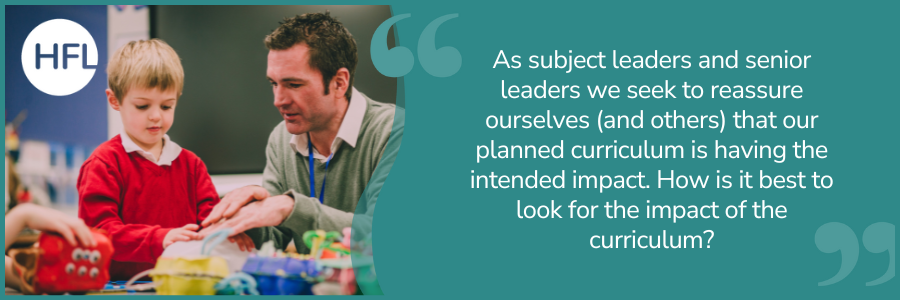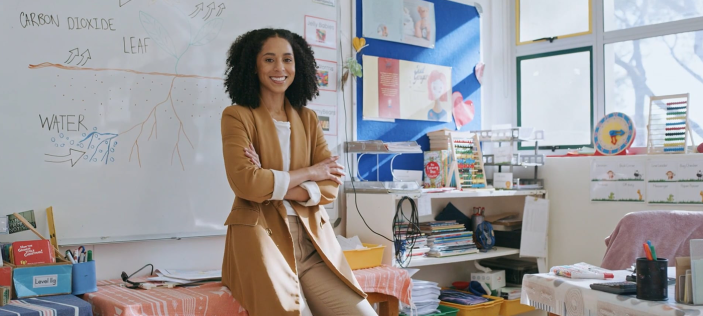
If you’ve recently attended any subject leader training, looked at the Ofsted handbook, or talked to leaders within your own school, you may well have seen, heard or used the terms ‘intent’, ‘implement’ and ‘impact’.
This vocabulary arrived with us in around 2018, (it was used in Ofsted’s ‘An investigation into how to assess the quality of education through curriculum intent, implementation and impact’, published December 2018). There has been much written about it since then.
When discussing the quality of education, the intent (including the aims and the structure), the implementation (the enactment of the intent, what actually happens), and the impact (the resulting outcomes), should be viewed as a whole. These are part and parcel of how the quality of education is evaluated. They cannot really be separated out, as this could give an incomplete view of the quality of education.
As the saying goes; ‘the proof of the pudding is in the eating’. Our judgement about the quality of education should focus not only on the intended curriculum and its implementation, but also on (and possibly most importantly on) the impact it is having.
When we look for impact, we are, therefore, exploring the outcomes (in their many forms) from the implementation of our intended curriculum: What outcomes has the implementation of our intended curriculum led to? Many a curious leader will then naturally want to consider the ‘how’ and ‘why’ questions: How has this impact come about? Why has this impact come about? The answers are often multi-layered, and this is where the interesting discussions, in turn, come about.
When we say that the quality of education is effective, we are likely to be saying that the intended curriculum has been implemented effectively and that the outcomes (in their many forms) demonstrate this. Conversely, when the outcomes are not what we expected/hoped for, we might look to the intended curriculum and/or its implementation to explore and unpick this: Why are we not (yet) having the intended impact?
Let’s ask ourselves some questions:
- Why might we look for the impact of our curriculum?
- How and where should we look for the impact of our curriculum?
- What should we look for as the impact of our curriculum?
Why might we look for the impact of our curriculum?
As school leaders, we want to be sure that we are providing pupils with the best possible education experiences we can. That we are equipping pupils for the next phase of their education, developing their knowledge and skills so that they can take advantage of a range of opportunities.
To be sure that we are providing pupils with the best possible education, we need to check on the impact – the outcomes: What do pupils know and remember of the intended curriculum, as a result of its implementation?
For example, as a history subject leader I might have within my ‘intent’ that the pupils will develop the skills of ‘thinking like a historian’; handling evidence and constructing narratives about the past, building up a rich understanding of what life was like.
However, if the implementation (teaching) misses the key point about handling evidence, then we are unlikely to have outcomes where pupils talk about how they have used evidence to build their understanding of what life was like. As a result, pupils are not making progress through the curriculum as leaders intend, and so the outcomes may not fully match the intent.
How and where should we look for the impact of our curriculum?
There are many different ways to look for the impact; some subjects have data collected nationally, such as the Key Stage 2 SATs. These outcomes are one measure of impact.
Pupils recorded learning, such as their work in books for example, may have captured the learning. Pupils may also demonstrate their learning in other ways, such as; taking part in discussions, making something, recording a podcast or making a poster. Often these show the learning at the time, within the lesson(s).
However, what is recorded by a pupil and what they might (or might not) achieve in a summative test is likely to have its limitations, at least in terms of measuring impact.
Talking to pupils, to discover whether they know more and remember more of the intended curriculum, might provide a more rounded profile of long-term impact. We might ask pupils, with examples of their work or books available, to talk us through their learning. Does the intended, taught vocabulary allow the pupils to express their learning clearly (for their age and stage of education)?
It is likely that a combination of the above will give a more rounded indication of impact. We may need to triangulate; having the curriculum planning or mapping alongside the recorded learning, any appropriate data, and the pupil voice. Together, what do these indicate?
What should we look for as the impact of our curriculum?
This question in the first instance should take us back to our intent (including both the aims and the structure). What did we want pupils to know and remember, to say and be able to do, as a result of the curriculum they have moved through?
The curriculum mapping and progression documents should set out what the school intends the pupils to know and be able to do. The ‘what’ we are looking for should therefore relate directly back to this learning and whether it has been secured in a way that means it has been retained and can be used in appropriate related contexts.
For this reason, having the curriculum mapping and/or progression documents in mind or to hand whilst looking at recorded outcomes and/or talking to pupils for example, will help us to explore direct correlations between the intended curriculum and the outcomes.
For example, as art and design subject leader, I may have mapped within a drawing and sketching strand, for shading techniques to be developed over Year 2 and Year 3 (hatching, cross hatching, finger blending, stippling), with the introduction of perspective then in Year 4 (using shading techniques learned and rehearsed in Years 2 and 3 to create perspective, through the use of light and dark).
Now, as I look for the impact, I will intentionally seek outcomes and evidence of impact which correlates back to the mapping. Do Year 2 and Year 3 pupils talk about the shading techniques they have learned about and rehearsed? Do Year 4 pupils talk about using these techniques to create perspective? Does their work in sketch books show this learning?
Top tips for subject and curriculum leaders:
- It is helpful to see ‘intent’, ‘implement’ and ‘impact’ as part and parcel of the same bigger picture: we are exploring the outcomes from the implementation of our intended curriculum
- We may need more than one tool or activity to do this; a combination of ‘outcomes’ may best demonstrate the impact, possibly including data (if/where appropriate), recorded learning and other outcomes, and also talking to pupils.
- The identified important or fundamental learning should be threaded through the intent (in any mapping and progression documents), and the implementation. It is this ‘fundamental learning’ that should be looked for in the outcomes: Have pupils secured and retained it? Can they use it in an appropriate related context?
- Any subject leader monitoring and evaluation activities should be rooted in the above 3 points. Our monitoring and evaluation should bring us back to answering: What is the quality of education like?
Getting to grips with ‘outcomes’ in subjects without published data can be a challenge. HFL education is committed to supporting schools to evaluate the quality of education across the curriculum. We would be pleased to help leaders explore the impact of the subject curriculum - to help clarify your thinking around outcomes in relation to the intended curriculum and its implementation. Please get in touch if we might be able to support you: kate.kellner-dilks@hfleducation.org



